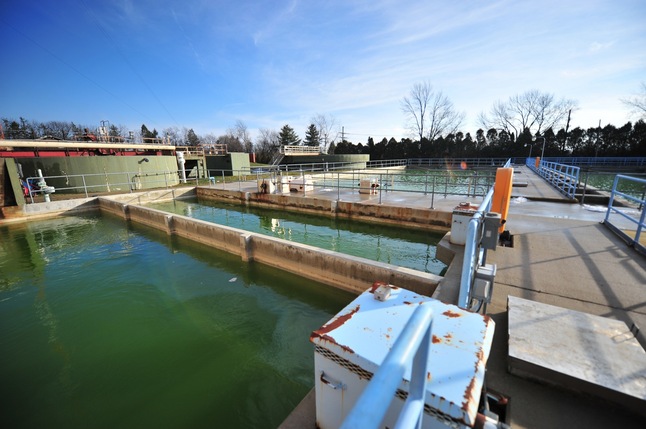
The Ann Arbor Water Treatment Plant includes two plants named Plant 1 and Plant 2. The treatment and settling basins for Plant 1, shown here, were constructed in 1938 and might need to be replaced in the next five to 10 years. Plant 1 was not treating water on this day but its basins, which are uncovered, were still filled with water being circulated to avoid freezing.
Ryan J. Stanton | AnnArbor.com
The plant pumps on average more than 15 million gallons of water per day to some 125,000 city water customers, including some in Scio and Ann Arbor townships.
City officials are beginning to seriously think about replacing portions of the plant that date back to the 1930s, and that's expected to cost tens of millions of dollars.
Tom Crawford, the city's chief financial officer, called attention to that fact at a recent city budget retreat, warning City Council members it's an issue on the horizon.
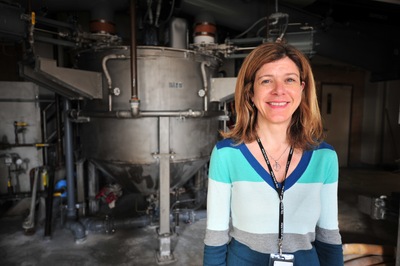
Molly Robinson has been the city's water treatment services manager since 2010 and before that was the city's water quality manager since 2007. She oversees a staff of about 30 employees at the Water Treatment Plant.
Ryan J. Stanton | AnnArbor.com
Molly Robinson, the city's water treatment services manager, said she's hoping the city moves forward soon with a study to nail down the costs and consider various options.
"There are a lot of new technologies out there that are different shapes and sizes, and it's hard to say what we'd go with, which is exactly why we need the study," she said.
Until a study is completed, city officials are hesitant to estimate what the project might cost, how much the city might have to borrow, and what impact it might have on water rates.
"Our goal would be to complete this study and get estimates for what it would cost to construct the new basins," Robinson said. "And then start looking at saving some money — setting some money aside so that, in five or 10 years, we would have some portion of the construction costs set aside and we wouldn't have to raise rates that much."
A tale of two plants
The city-run water treatment facility at 919 Sunset Road is comprised of two lime-softening plants, an ozone generation building, chemical addition and filtration units, pumps and storage.
Craig Hupy, the city's public services administrator, said the two plants are referred to as Plant 1 and Plant 2. The treatment and settling basins for Plant 1 were constructed in 1938. The basins for Plant 2 were constructed between the late 1960s and early 1970s.
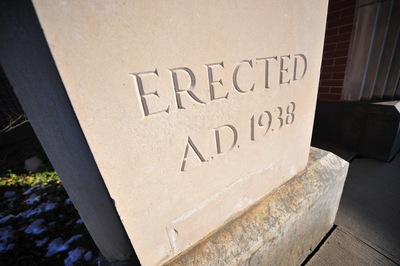
A marking near the entrance to the Ann Arbor Water Treatment Plant indicates its age.
Ryan J. Stanton | AnnArbor.com
Robinson briefed City Administrator Steve Powers on the issue in a Jan. 14 memo, noting water treatment technology and basin design have significantly improved since Plant 1's basins were constructed three-quarters of a century ago. She said the rectangular basins contain many moving parts, are inefficient in mixing and sludge removal, and are maintenance-intensive.
"We'll have two or three guys spend four or five days at a time hosing out these basins in the spring and fall because of the sludge accumulation in the corners," Robinson said, overlooking Plant 1 on a recent afternoon. "Because they're not circular, the sludge tends to form in the corners and it can't get out unless we come in with fire hoses and actually push the sludge out."
In 2006, the city completed a master plan for the Water Treatment Plant. A prioritized list of capital improvement projects was generated based on the plan's recommendations.
The highest priority was replacement of the lime storage and feed systems for both plants, since they were found to be in poor condition and posed a safety hazard.
Robinson said the city immediately began planning for the replacement, secured low-interest loans and other funding for the project, and in 2010 began construction. One of the systems is in service now, and construction for the second is expected to be complete in June 2013.
That's costing the city about $4.4 million.
Another recommended project in the master plan is replacement of Plant 1's basins. In order to complete a project of that magnitude, Robinson said, the city must begin planning years in advance of the actual construction, just as it did with the lime feed storage system replacement.
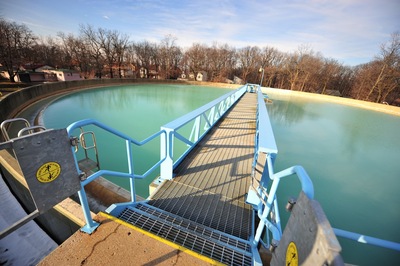
The circular basins for Plant 2 were constructed between the late 1960s and early 1970s.
Ryan J. Stanton | AnnArbor.com
"The other thing is this requires a lot of space, as you can see," she said, standing over the rectangular basins.
The newer plant, which has circular basins, has a maximum output of 28 million gallons per day, while the original plant from the 1930s has a maximum output of 22 million gallons per day.
"If you were to replace this with new technology, you could put all 50 million gallons in this same footprint," Robinson said, noting that could free up space on site for new treatment processes that might be required in the future because of new regulations.
"It could allow us to put in a full-scale research facility, which is actually my vision of the future here in Ann Arbor," she added.
With a full-scale research facility, Robinson believes Ann Arbor could become a national leader in studying emerging contaminants and technology.
"We have a unique opportunity here because we have the University of Michigan and Eastern Michigan University right in our backyard," she said. "So we have partnership opportunities we could be taking advantage of. There are constantly requests for participation in studies on emerging contaminants and things like that — new technologies."
Planning for the future
About 85 percent of the water pumped to the Water Treatment Plant comes from an intake pipe at Barton Pond, while 15 percent comes from wells located at the city's airport.
"We're one of only seven inland river supplies in Michigan, and so we're unique in that way," Robinson said, adding that presents unique treatment challenges.
Because the city uses surface water as a source, the water goes through a complete treatment that consists of rapid mixing for quick dispersion of chemicals being added, flocculation to give the chemical reaction time it needs, settling to allow the removal of solids by gravity, and filtration.
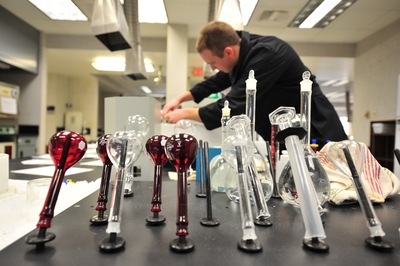
John Danielson, an environmental lab analyst for the city of Ann Arbor, fixes a squeaky water pump that helps cool the graphite furnace on an atomic absorption spectrometer on a recent afternoon.
Ryan J. Stanton | AnnArbor.com
When AnnArbor.com visited the site on a recent afternoon, Plant 1 was not in service. Robinson explained that's typical.
While no water was being treated by Plant 1, it was in standby mode. If something happened to Plant 2, the older plant would be ready to go.
"Most of the year, we only need one of them. In the summer, we will run both plants," Robinson said. "In drinking water, we always want to have redundancy. We need to be able to take one plant out of service and then provide water to everybody without interruption."
Asked whether replacement of Plant 1's basins could end up being as expensive as renovations at the city's 1930s-era Wastewater Treatment Plant, Robinson said that's unlikely. The City Council voted nearly a year ago to authorize up to $120 million in revenue bonds for that project.
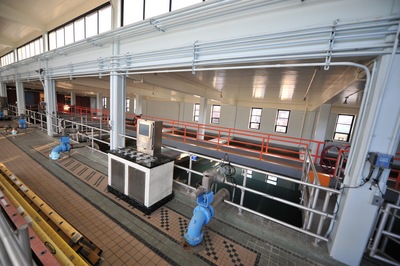
Because the city uses surface water as a source, the water goes through a complete treatment that consists of rapid mixing for quick dispersion of chemicals being added, flocculation to give the chemical reaction time it needs, settling to allow the removal of solids by gravity, and filtration.
Ryan J. Stanton | AnnArbor.com
Heavy construction equipment has been on site at the Water Treatment Plant lately as part of the West High Service Pump Station Project. The $11 million project includes replacement of aging pumping equipment that serves the west side of Ann Arbor and Scio Township, and the cost is being shared with Scio Township.
That project includes construction of a three-story pump station (two floors below grade) next to the eastern side of the plant's administration building.
As city officials turn their attention to Plant 1, Robinson said she feels confident the city is ahead of the curve in terms of planning for the Water Treatment Plant's future.
"The whole idea of starting the study now is so that we can be quite proactive in our planning and we don't find ourselves in a situation where we feel a sense of urgency," she said. "Because the last thing you want with drinking water is to feel a sense of urgency. You always want to plan in advance."
Ryan J. Stanton covers government and politics for AnnArbor.com. Reach him at ryanstanton@annarbor.com or 734-623-2529. You also can follow him on Twitter or subscribe to AnnArbor.com's email newsletters.